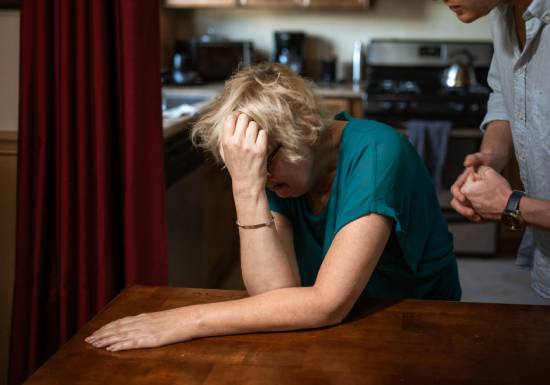Last Updated on November 27, 2023 by cmv
Recovering from trauma and Post-Traumatic Stress Disorder (PTSD) is a journey that requires healing from within. It’s about finding the strength to face the pain, release the past, and reclaim control over one’s life. In this article, we explore the path to recovery from trauma and PTSD, delving into the various approaches that can help individuals rebuild their lives.
Healing from within is not a one-size-fits-all process. It involves a combination of therapeutic techniques, support systems, and individual empowerment. From traditional therapies such as Cognitive-Behavioral Therapy (CBT) and Eye Movement Desensitization and Reprocessing (EMDR) to alternative treatments like mindfulness, meditation, and yoga, there are numerous resources available to support individuals on their healing journey.
Additionally, self-care practices play a vital role in trauma recovery. Engaging in activities that promote relaxation, self-expression, and emotional release can contribute to healing and rebuilding a sense of self. Building a strong support network of trusted loved ones, therapists, or support groups can also make a significant difference.
Regardless of the method chosen, the ultimate goal is to find a path that resonates with the individual, allowing them to heal at their own pace and in their own way. By embracing the process and focusing on self-compassion, those affected by trauma can gradually regain their inner strength and embark on a journey of recovery.
The impact of trauma on mental health
Trauma is an emotional response to a distressing or disturbing event that overwhelms an individual’s ability to cope. It can be caused by various experiences, such as physical or sexual abuse, natural disasters, accidents, or witnessing violence. Traumatic events can have a profound impact on mental health, leading to the development of PTSD.
Post-Traumatic Stress Disorder (PTSD) is a mental health condition that may occur after experiencing or witnessing a traumatic event. Individuals with PTSD often experience intrusive memories, nightmares, flashbacks, and intense emotional or physical reactions. The symptoms can significantly impair their daily functioning and quality of life.
Understanding trauma and PTSD is the first step towards recovery. It allows individuals to recognize their experiences as valid and provides a foundation for seeking appropriate help and support. By acknowledging the impact of trauma, individuals can begin to address the underlying issues and work towards healing.
Signs and symptoms of trauma and PTSD

Trauma affects mental health in profound ways. It can disrupt one’s sense of safety, trust, and self-worth. The emotional and psychological impact of trauma can manifest in various symptoms, including anxiety, depression, hypervigilance, irritability, and difficulty concentrating.
Furthermore, trauma can lead to the development of maladaptive coping mechanisms, such as substance abuse or self-destructive behaviors, as individuals attempt to numb or escape their pain. Left untreated, trauma can have long-lasting effects on mental health, relationships, and overall well-being.
It is crucial to recognize the connection between trauma and mental health and seek appropriate support. By addressing the root causes of trauma and its impact on mental health, individuals can begin to heal and rebuild their lives.
The importance of seeking professional help
Recognizing the signs and symptoms of trauma and PTSD is essential for early intervention and effective treatment. While the specific symptoms may vary from person to person, common signs include:
1. Intrusive memories: Recurrent and distressing memories of the traumatic event that can be triggered by certain cues or reminders.
2. Nightmares and flashbacks: Vivid and distressing dreams or sudden re-experiencing of the traumatic event, often causing intense emotional or physical reactions.
3. Avoidance: Avoiding places, people, or activities that remind the individual of the traumatic event, in an attempt to minimize distress.
4. Hyperarousal: Feeling constantly on edge, irritable, or easily startled. This heightened state of alertness can lead to difficulty sleeping or concentrating.
5. Negative thoughts and mood: Persistent negative beliefs about oneself or the world, feelings of guilt or shame, and a diminished interest in previously enjoyed activities.
If you or someone you know is experiencing these symptoms, it is important to seek professional help. A qualified mental health professional can assess the situation and provide appropriate guidance and treatment options.
Different approaches to trauma therapy
Seeking professional help is a crucial step in the journey towards healing from trauma and PTSD. A mental health professional, such as a therapist or counselor, can provide the necessary support, guidance, and evidence-based treatments to address the underlying issues.
Therapeutic approaches like Cognitive-Behavioral Therapy (CBT) and Eye Movement Desensitization and Reprocessing (EMDR) have been shown to be effective in treating trauma and PTSD. CBT helps individuals identify and change negative thought patterns and behaviors associated with trauma, while EMDR focuses on processing traumatic memories and reducing their impact.
Professional help also offers a safe space for individuals to explore and express their emotions, gain insight into their experiences, and develop healthy coping strategies. A skilled therapist can provide validation, empathy, and practical tools for managing symptoms and rebuilding resilience.
Remember, seeking professional help is not a sign of weakness but a courageous step towards reclaiming control over one’s life and finding healing.
Self-care and coping strategies for trauma recovery

When it comes to trauma therapy, different approaches can be used based on individual needs and preferences. Here are a few commonly used techniques:
1. Cognitive-Behavioral Therapy (CBT): CBT helps individuals identify and challenge negative thought patterns and behaviors associated with trauma. It focuses on developing healthier coping mechanisms and changing unhelpful beliefs.
2. Eye Movement Desensitization and Reprocessing (EMDR): EMDR is a specialized therapy that helps individuals process traumatic memories by using eye movements or other forms of bilateral stimulation. This technique aims to reduce the distress associated with traumatic experiences.
3. Mindfulness and meditation: These practices involve cultivating present-moment awareness and non-judgmental acceptance of one’s thoughts and emotions. Mindfulness and meditation can help individuals develop emotional regulation skills and reduce anxiety and stress.
4. Yoga and body-based therapies: Yoga and other body-based therapies focus on integrating the mind and body to promote healing. These practices can help individuals reconnect with their bodies, release tension, and enhance self-awareness.
It is important to work with a qualified professional to determine the most suitable approach for individual healing. Each person’s journey is unique, and therapy should be tailored to their specific needs and preferences.
The role of support systems in healing from trauma
Self-care plays a vital role in trauma recovery. Engaging in activities that promote relaxation, self-expression, and emotional release can contribute to healing and rebuilding a sense of self. Here are some self-care strategies that can support the recovery process:
1. Engage in regular physical exercise: Exercise releases endorphins, which can improve mood and reduce symptoms of anxiety and depression. It can also help individuals reconnect with their bodies and release pent-up energy.
2. Practice relaxation techniques: Deep breathing, progressive muscle relaxation, and guided imagery are relaxation techniques that can help reduce stress and promote a sense of calm.
3. Express emotions through creative outlets: Writing, painting, dancing, or playing a musical instrument can provide an outlet for emotional expression and promote self-discovery.
4. Establish healthy sleep habits: Prioritize getting enough sleep and create a soothing bedtime routine. Adequate rest can improve overall well-being and help regulate emotions.
5. Nourish your body with a balanced diet: Eating a nutritious diet can support overall physical and mental health. Avoiding excessive caffeine and alcohol is also important, as they can exacerbate symptoms of anxiety and depression.
Remember, self-care is not selfish but necessary for healing and maintaining well-being. Prioritizing self-care allows individuals to recharge, reduce stress, and build resilience.
Overcoming obstacles on the path to recovery
Building a strong support network is crucial for individuals healing from trauma. Trusted loved ones, therapists, or support groups can provide emotional validation, understanding, and encouragement throughout the recovery process. Here’s how support systems can contribute to healing:
1. Emotional validation: Supportive individuals can provide a safe space for trauma survivors to share their experiences and emotions without judgment. This validation helps individuals feel heard, understood, and less alone.
2. Encouragement and motivation: Support systems can offer encouragement and motivation during challenging times. They can remind individuals of their progress and provide the necessary support to keep going.
3. Shared experiences: Connecting with others who have experienced similar trauma can be a powerful source of support. Support groups or online communities provide an opportunity to share experiences, exchange coping strategies, and learn from one another.
4. Practical assistance: Supportive friends and family members can offer practical assistance, such as accompanying individuals to therapy sessions or helping with daily tasks during particularly difficult periods.
5. Safety and security: Being surrounded by a supportive network can provide a sense of safety and security. This allows individuals to take risks, explore their emotions, and work through their trauma in a nurturing environment.
It is important to choose support systems wisely and surround oneself with individuals who are understanding, compassionate, and respectful of personal boundaries.
Resources and tools for trauma survivors
The path to recovery from trauma and PTSD is not without its challenges. It is essential to acknowledge and address the obstacles that may arise along the way. Here are some common obstacles and strategies for overcoming them:
1. Fear and avoidance: Fear and avoidance can prevent individuals from confronting their trauma and seeking help. It is important to gently challenge these fears and gradually expose oneself to triggers in a safe and controlled manner.
2. Shame and self-blame: Trauma survivors may experience feelings of shame and self-blame, which can hinder the healing process. Seeking therapy and working with a mental health professional can help challenge and reframe these negative beliefs.
3. Patience and self-compassion: Recovery takes time, and progress may not always be linear. It is important to practice patience and self-compassion, acknowledging that healing is a gradual process with ups and downs.
4. Reluctance to trust: Trauma can erode trust in oneself and others. Rebuilding trust requires establishing healthy boundaries, setting realistic expectations, and gradually allowing oneself to open up to trusted individuals.
By recognizing and addressing these obstacles, individuals can navigate their healing journey with greater resilience and determination.
Conclusion: The journey to healing and resilience
Numerous resources and tools are available to support trauma survivors on their journey to recovery. Here are a few options to consider:
1. Books and educational materials: There are many books and online resources that provide information, guidance, and support for trauma survivors. Recommended titles include “The Body Keeps the Score” by Bessel van der Kolk and “The PTSD Workbook” by Mary Beth Williams.
2. Mobile apps and online platforms: Mobile applications like Calm and Headspace offer guided meditations and relaxation exercises, while online platforms like BetterHelp and Talkspace provide access to therapy from the comfort of one’s own home.
3. Support groups and community organizations: Joining support groups or community organizations can provide a sense of belonging, understanding, and shared experiences. They offer a safe space to connect with others who have gone through similar experiences.
4. Helplines and crisis centers: Helplines such as the National Suicide Prevention Lifeline (1-800-273-TALK) or the Crisis Text Line (Text “HOME” to 741741) provide immediate support and resources for individuals in crisis.
Remember, reaching out for help is a sign of strength, and utilizing available resources can enhance the healing process.
For more information on trauma, contact us today.
Counsel Me Vancouver




